FAQ - Advanced Bathroom Queries
2 Button Toilet Flush Replacement

Fed up with the outdated single button toilet flush mechanism? We have great news for you!
In this article, we’ll show you how to upgrade to a more efficient and convenient 2 button flush system.
With this modern technology, you’ll have the power to choose between a full flush or a half flush, saving water and money in the process.
So, let’s dive in and master the art of 2 button toilet flush replacement!

Key Takeaways
- 2 Button flush systems allow users to choose between full flush and half flush based on waste volume
- These systems significantly conserve water and reduce utility bills
- Choosing a reliable and durable system is important when replacing a 2 button toilet flush
- When installing the new flush mechanism, it is necessary to shut off the water supply and properly dispose of old flush mechanism parts
Benefits of 2 Button Flush Systems
We love the efficiency and water-saving benefits of 2 button flush systems. These systems offer distinct advantages over traditional single flush toilets. Firstly, they allow users to choose between a full flush and a half flush, depending on the waste volume. This flexibility ensures that only the necessary amount of water is used, resulting in significant water conservation and reduced utility bills.
Additionally, 2 button flush systems are more environmentally friendly, as they contribute to water preservation and sustainability. However, there are a few disadvantages to consider. The complexity of the system may require a higher initial investment and potentially more maintenance. It’s crucial to choose a reliable and durable 2 button flush system to prevent any future issues.
Now that we understand the benefits and drawbacks, let’s explore how to choose the right 2 button flush system.
How to Choose the Right 2 Button Flush System
To continue our exploration of 2 button flush systems, let’s delve into the process of selecting the ideal system for your needs.
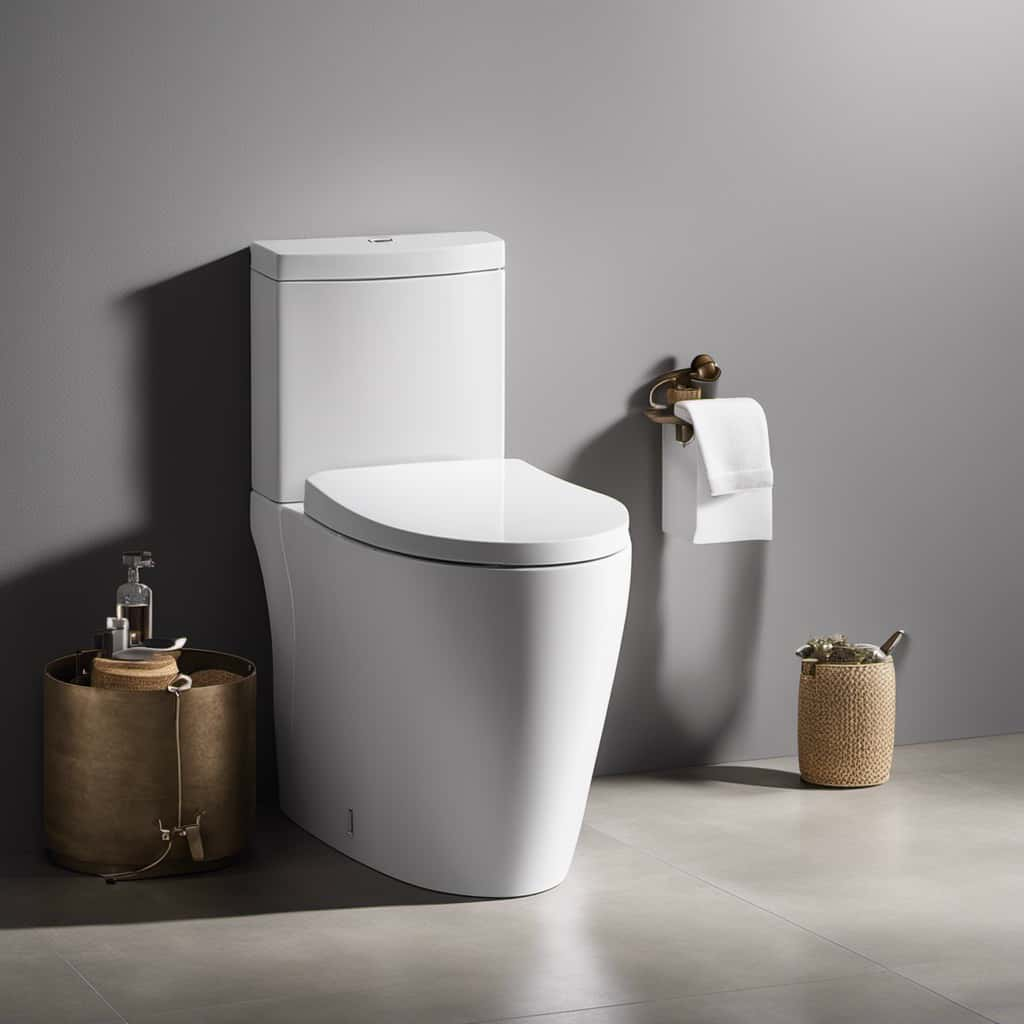
When choosing a toilet flush system, it’s important to consider the following factors:
- Water Efficiency: Look for a dual flush system that offers different flush options, typically a full flush for solid waste and a half flush for liquid waste. This can help reduce water consumption and promote sustainability.
- Flush Power: Consider the flush power of the system. Look for a system that provides a strong flush to ensure effective waste removal and prevent clogs.
- Durability: Choose a flush system that’s built to last. Look for high-quality materials and components that can withstand regular use without wearing out or malfunctioning.
- Compatibility: Ensure that the flush system you choose is compatible with your toilet model. Check the specifications and consult with a professional if needed to ensure a proper fit.
Tools and Materials Needed for Installation
Continuing our exploration of 2 button flush systems, let’s now discuss the tools and materials needed for the installation process.
When replacing a button toilet flush, you’ll need a few essential tools. Firstly, a adjustable wrench will be necessary to disconnect the water supply line from the old flush system. Additionally, a flathead screwdriver will come in handy for removing the old button assembly. To ensure a secure installation, you’ll also need a pair of pliers to tighten any loose connections.
In terms of materials, you’ll need a new button flush system, which typically includes the button assembly, the flush valve, and the fill valve. It’s important to choose high-quality materials to ensure durability and proper functioning. Lastly, don’t forget to have a roll of Teflon tape on hand to seal any threaded connections.
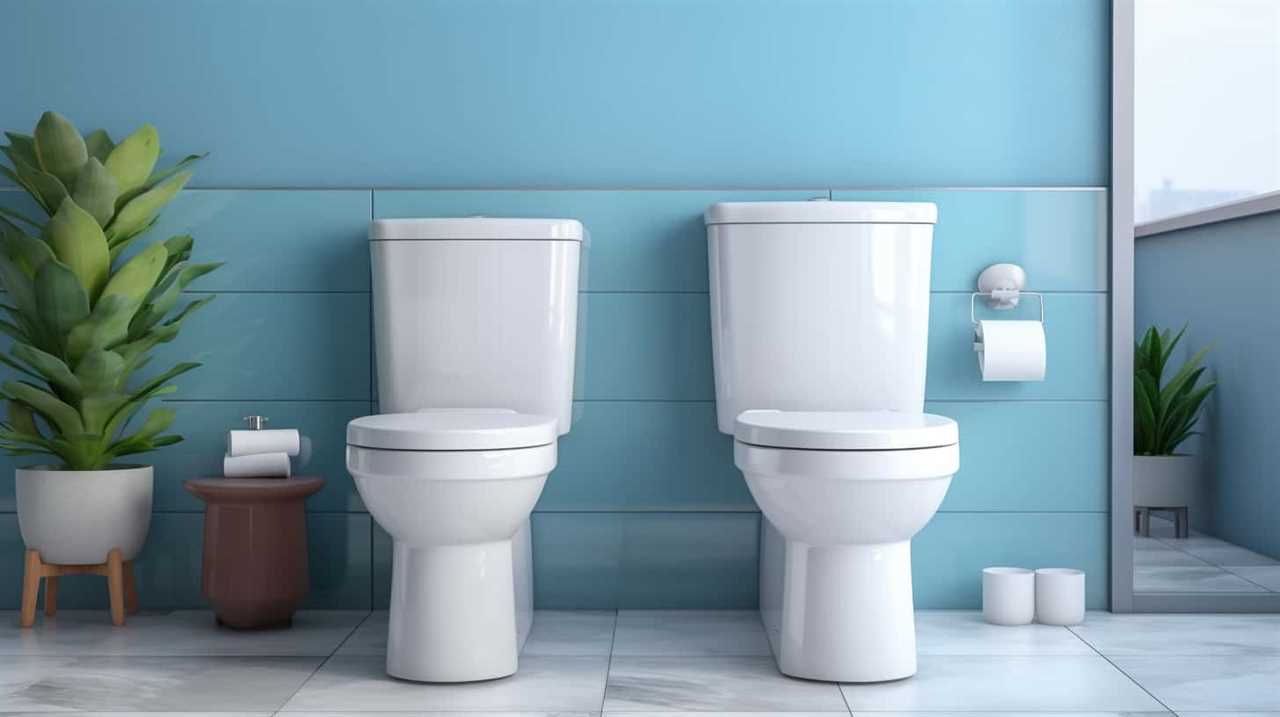
With the right tools and materials, you can successfully replace your button toilet flush system.
Step 1: Shut off the Water Supply
Before beginning the process of replacing the button toilet flush, it’s crucial to shut off the water supply. This step is essential to prevent any potential water damage and ensure a safe working environment.
Importance of Shutting off
We always emphasize the necessity of turning off the water supply as the initial step in replacing a button toilet flush. Shutting off the water supply is crucial for several reasons:
- Preventing potential risks: By shutting off the water supply, you eliminate the risk of accidental flooding or leaks during the replacement process. This ensures a safe and dry environment to work in.
- Avoiding water wastage: Water conservation is an important aspect to consider. By shutting off the water supply, you prevent unnecessary water wastage while replacing the button toilet flush. This aligns with our commitment to environmental responsibility.
- Minimizing damage: In case of any unexpected issues or complications during the replacement, shutting off the water supply minimizes the potential damage that could occur. It allows you to address the problem without further exacerbating the situation.
- Facilitating smooth installation: By shutting off the water supply, you provide a stable and controlled environment for the installation of the new button toilet flush. This ensures a seamless and successful replacement process.
Potential Water Damage
To begin safeguarding against potential water damage, our first step is to shut off the water supply.

Water damage prevention is essential to maintain the integrity and functionality of your toilet. Signs of water damage can include discoloration or staining on walls or ceilings, peeling paint or wallpaper, musty odors, or a noticeable increase in your water bill.
By shutting off the water supply, you can prevent any further leakage or flooding while you work on replacing the button toilet flush. This step is crucial in minimizing the risk of water damage and ensuring a smooth and successful replacement process.
Now that we’ve shut off the water supply, let’s move on to discussing the safety precautions to take during the button toilet flush replacement.
Safety Precautions to Take
To ensure the safety of the replacement process, it’s important to shut off the water supply before proceeding with the button toilet flush replacement. Taking proper safety measures is crucial to avoid any accidents or water damage during the installation. Here are four installation tips to follow:

- Locate the water shut-off valve: Usually, it’s located near the base of the toilet or on the wall behind it. Turn the valve clockwise to shut off the water supply.
- Flush the toilet: This step is essential to drain the water from the tank and bowl completely.
- Disconnect the water supply line: Use an adjustable wrench to loosen the nut connecting the water supply line to the bottom of the tank. Once loosened, remove the supply line.
- Double-check the water supply: Turn on a nearby faucet to ensure that the water supply is fully shut off before proceeding with the replacement.
Step 2: Remove the Old Flush Mechanism
Now that we’ve shut off the water supply, we can move on to removing the old flush mechanism.
This involves disconnecting the various components that make up the mechanism, such as the handle, chain, and flapper valve.
It’s important to properly dispose of these parts according to local regulations.
Disconnecting Old Flush Mechanism
We will begin by removing the old flush mechanism from the toilet. This step is crucial in replacing the button toilet flush.
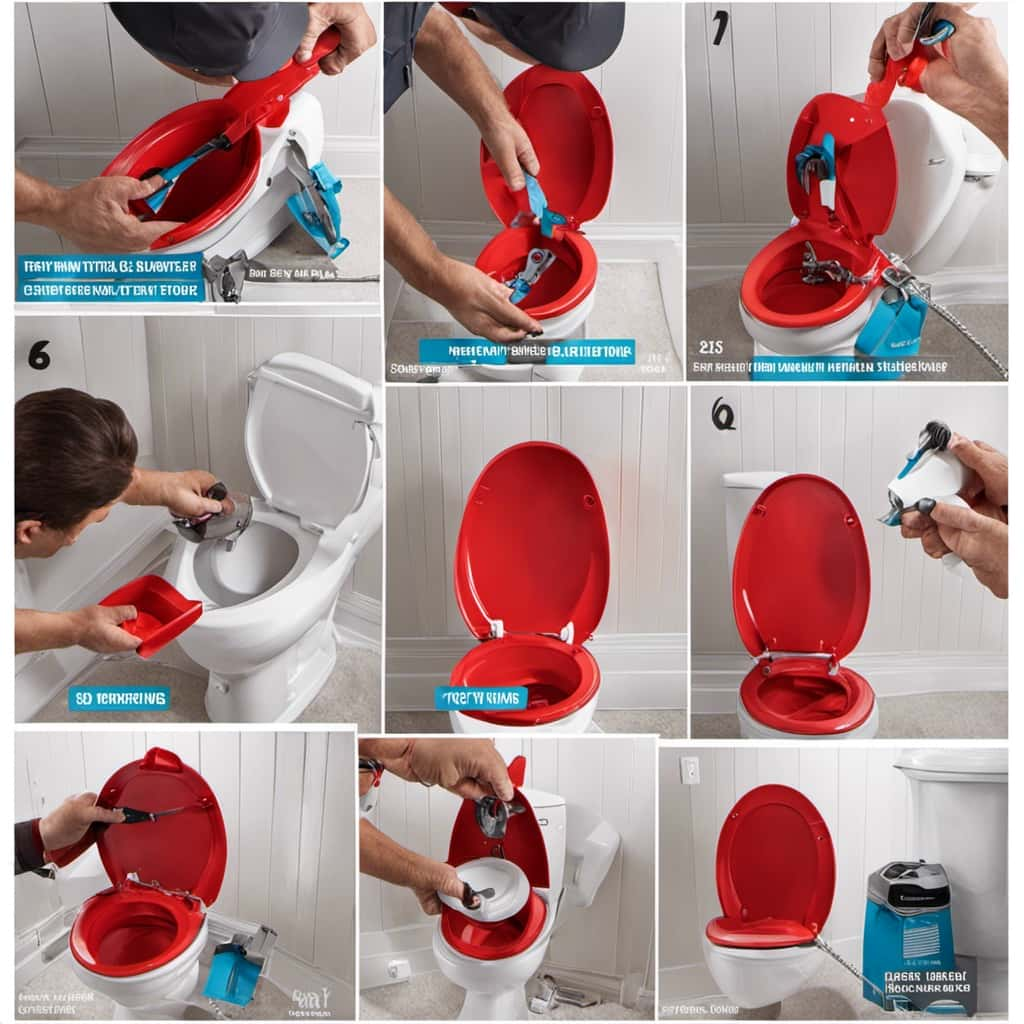
Here are the four steps to disconnect the old flush mechanism:
- Locate the water supply valve: Before starting, turn off the water supply to the toilet. Look for the water supply valve, typically located near the base of the toilet.
- Empty the tank: Flush the toilet to drain the water from the tank. This will prevent any water spillage during the disassembly process.
- Disconnect the chain: Locate the chain that connects the flush handle to the flush mechanism. Unhook the chain from the flush lever and remove it from the mechanism.
- Remove the mounting bolts: Using a wrench or pliers, loosen and remove the mounting bolts that secure the flush mechanism to the toilet tank. Once the bolts are removed, carefully lift the old flush mechanism out of the tank.
Proper Disposal of Parts
After disconnecting the old flush mechanism, we can now proceed with the proper disposal of its parts.
It’s crucial to dispose of these parts responsibly to minimize the environmental impact.
There are several disposal methods that you can consider.
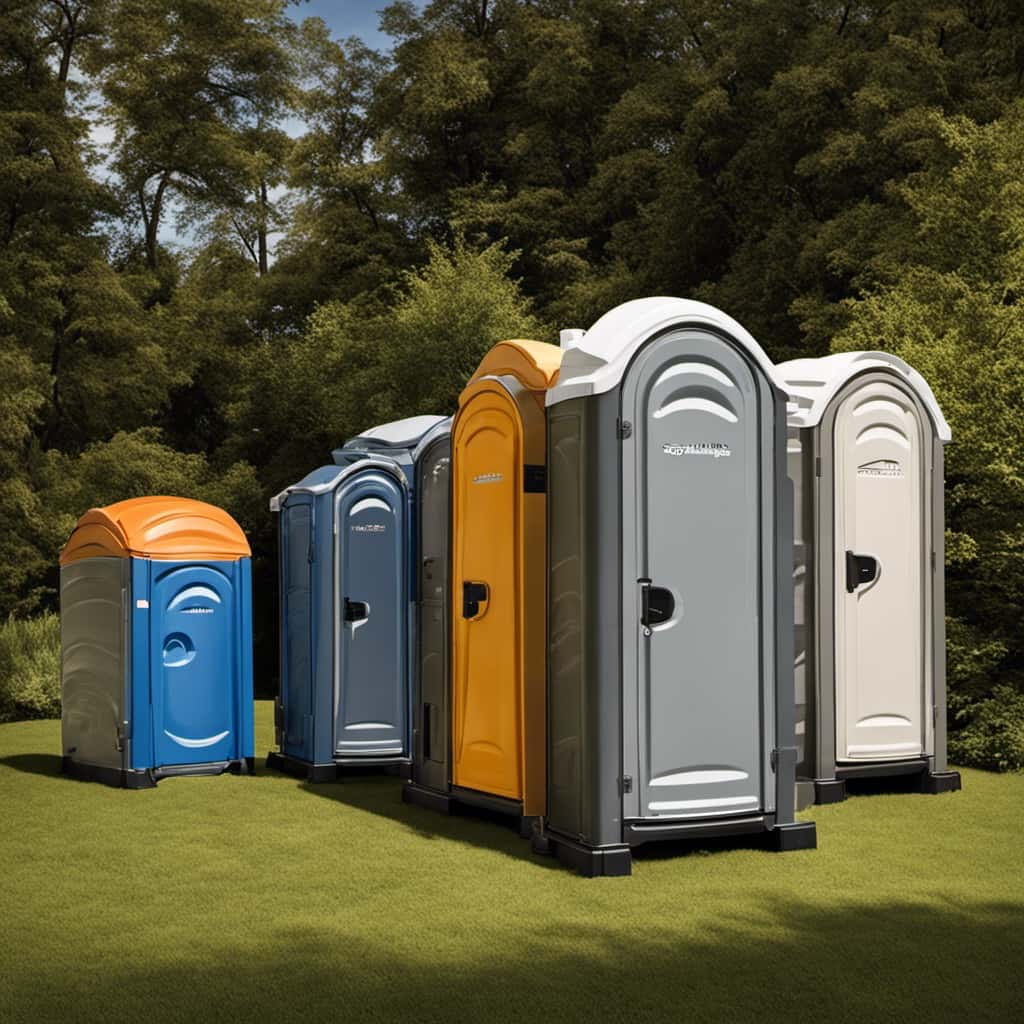
One option is to check if your local waste management facility accepts these parts for recycling. Many components of the flush mechanism, such as plastic and metal, can be recycled and repurposed.
Another option is to contact the manufacturer or retailer of the new flush mechanism to inquire if they’ve a take-back program for old parts. This ensures that the parts are disposed of in an environmentally friendly manner.
Installing New Flush Mechanism
To begin, let’s tackle the task of removing the old flush mechanism by carefully disconnecting it. Here are the steps to follow:
- Turn off the water supply: Locate the shut-off valve near the toilet and turn it clockwise to shut off the water flow. This will prevent any water leakage during the removal process.
- Empty the tank: Flush the toilet to empty the tank completely. This will make it easier to access and remove the old flush mechanism.
- Disconnect the chain or rod: Identify the chain or rod that connects the flush handle to the flush mechanism. Disconnect it by removing any clips or screws holding it in place.
- Remove the flush mechanism: Carefully unscrew or unclip the old flush mechanism from the toilet tank. Be cautious not to damage any surrounding parts.
Step 3: Install the New 2 Button Flush System
Let’s begin by installing the new 2 button flush system. To ensure a successful installation, follow these step-by-step instructions.
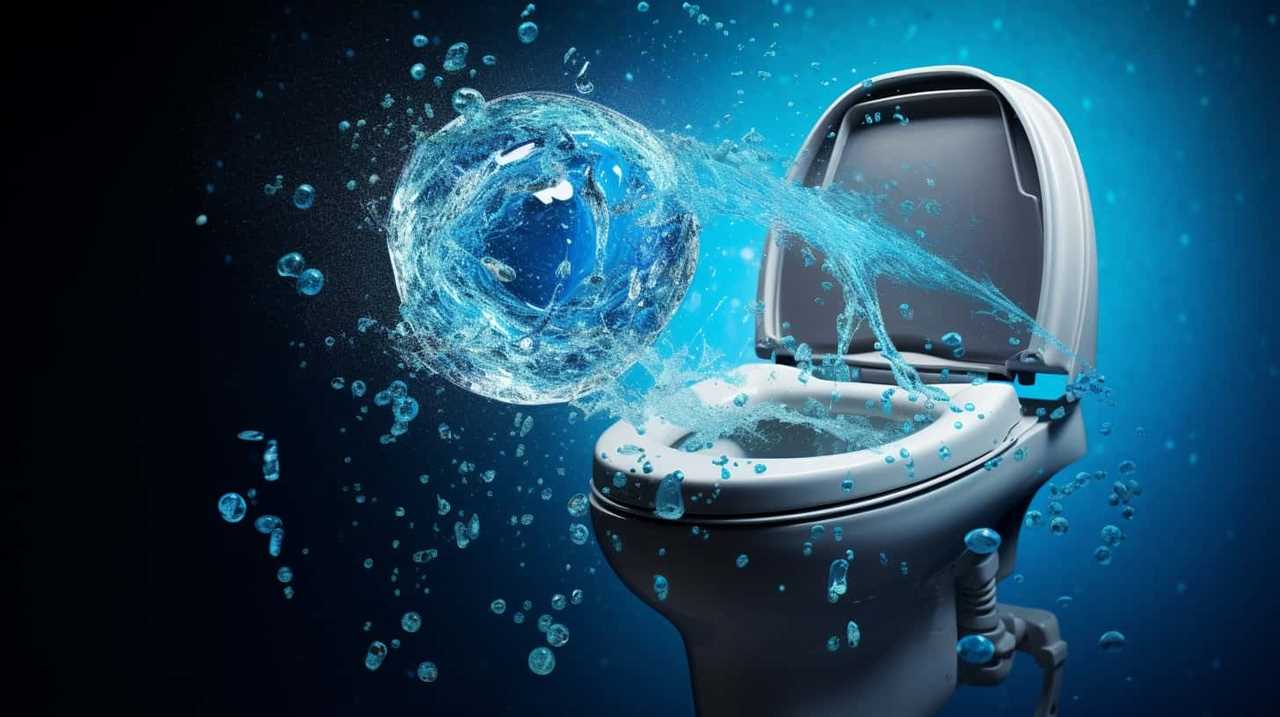
- First, turn off the water supply to the toilet by closing the shut-off valve.
- Next, remove the old flush mechanism by disconnecting the chain and unscrewing the mounting nut. Take care not to damage any surrounding components.
- Now, position the new 2 button flush system in place, aligning it with the mounting holes. Secure it by tightening the mounting nut.
- Reconnect the chain to the flush handle and adjust its length if necessary.
- Finally, turn on the water supply and test the new flush system. If you encounter any issues, refer to the troubleshooting tips provided in the manufacturer’s instructions.
Step 4: Adjusting the Water Level
Now that we’ve installed the new 2 button flush system, it’s important to adjust the water level to ensure proper functionality.
Correct water level is crucial for efficient flushing and preventing any issues with water flow.
If you notice low water in the tank, troubleshooting the cause and making the necessary adjustments will help maintain optimal performance.
Correct Water Level
We can easily adjust the water level to ensure proper functioning of the button toilet flush. Maintaining the correct water level is crucial for efficient flushing and preventing any issues with the system.
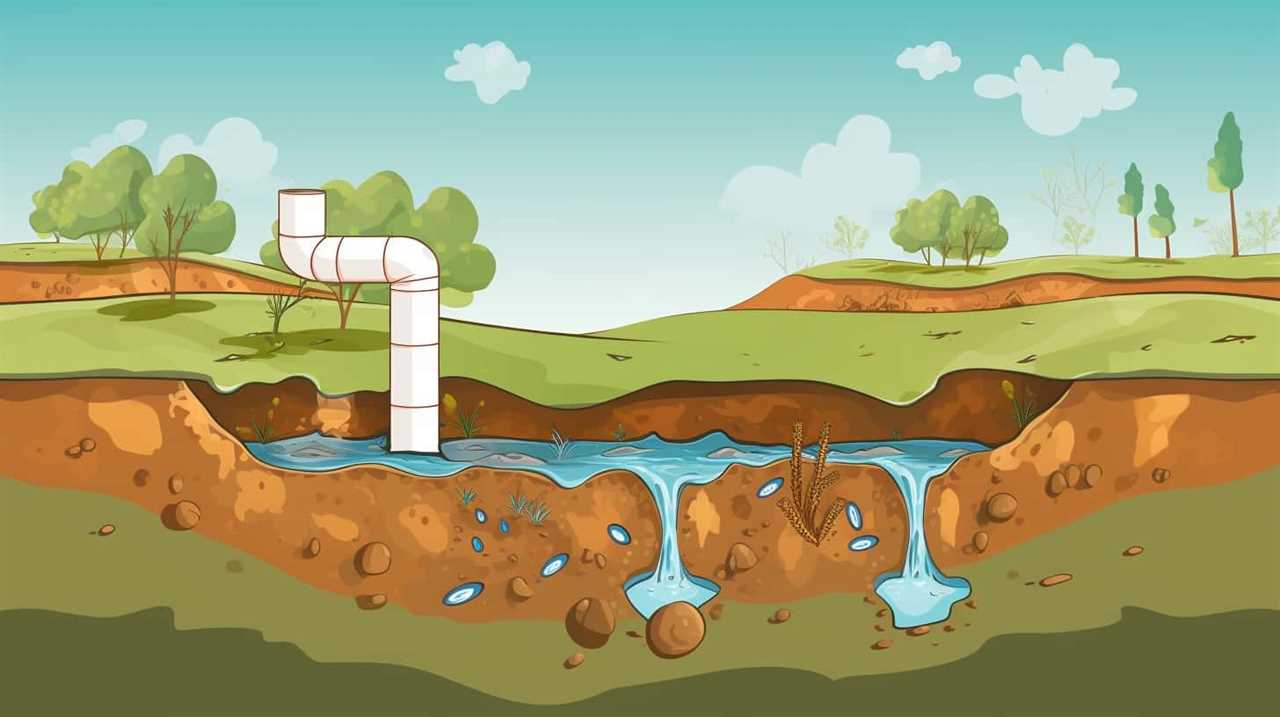
Here are four important points to consider when adjusting the water level:
- Correct water pressure: It’s essential to check the water pressure in your plumbing system to ensure it’s within the recommended range. High water pressure can cause excessive water usage and potential damage to the toilet flush mechanism.
- Benefits of water conservation: By adjusting the water level to the appropriate amount, you can contribute to water conservation efforts. Using less water per flush not only helps the environment but also reduces your water bills.
- Proper float adjustment: The float inside the toilet tank regulates the water level. Adjusting the float to the correct height will ensure that the tank fills up to the desired level after each flush.
- Checking for leaks: After adjusting the water level, it’s crucial to check for any leaks. Leaks can waste water and affect the proper functioning of the button toilet flush.
Importance of Adjustment
Adjusting the water level is crucial for ensuring proper functioning of the button toilet flush. It’s important to understand the importance of proper flushing and the benefits of water conservation. By adjusting the water level correctly, we can optimize the flushing power while minimizing water usage.
Proper flushing ensures that waste is effectively cleared from the toilet bowl, preventing clogs and maintaining hygiene. Adjusting the water level allows us to control the amount of water used for each flush, reducing unnecessary wastage. This not only helps conserve water, but also reduces water bills and promotes environmental sustainability.
A well-adjusted water level also ensures that the toilet flush operates efficiently. If the water level is too low, the flush may not be powerful enough to remove waste effectively. On the other hand, if the water level is too high, it may cause overflowing or constant running, leading to water wastage and potential damage to the toilet.
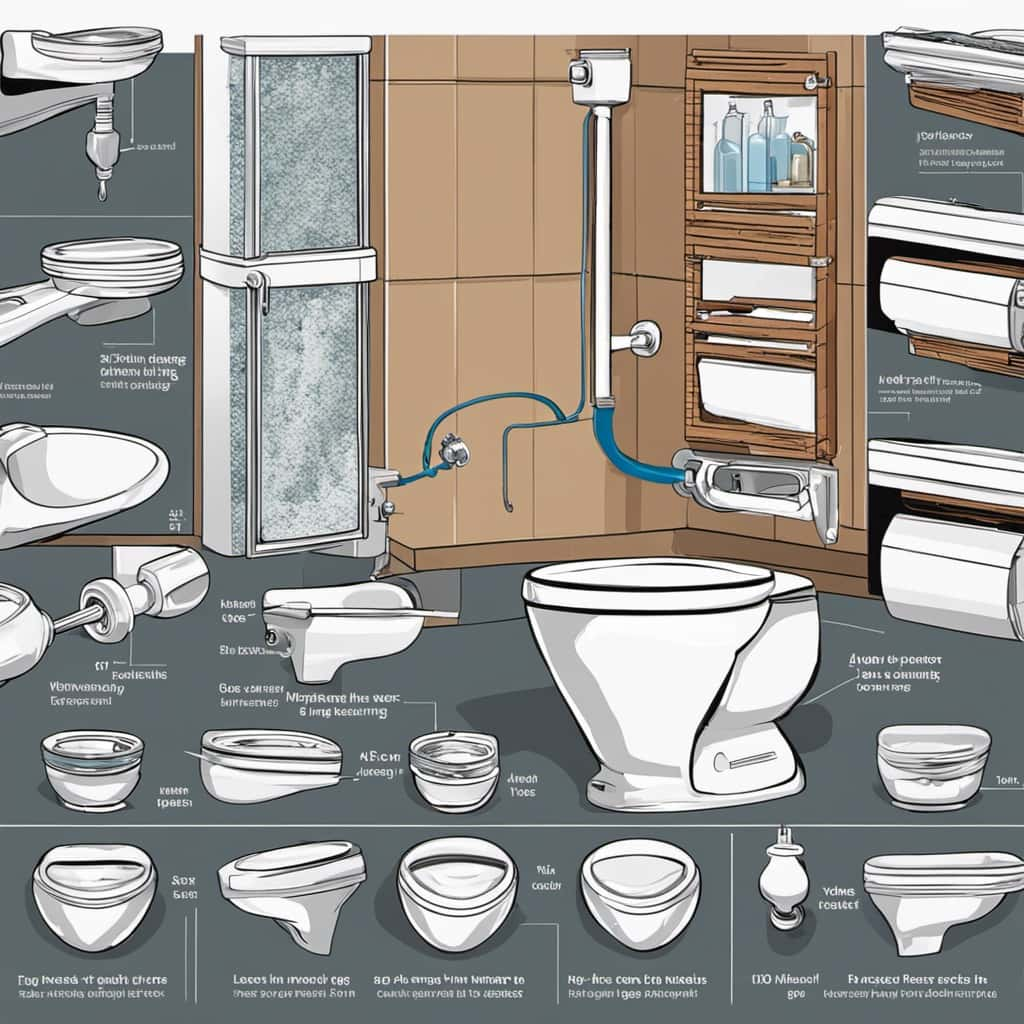
Troubleshooting Low Water
After checking for any possible leaks or blockages, we can troubleshoot low water in a button toilet flush by adjusting the water level. Here are four steps to fix a weak flush:
- Locate the water level adjustment screw: This screw is usually found on top of the fill valve, which is inside the toilet tank. Use a screwdriver to turn the screw counterclockwise to lower the water level or clockwise to raise it.
- Test the flush: After adjusting the water level, flush the toilet to see if the water flow has improved. If not, proceed to the next step.
- Check the fill valve height: Ensure that the fill valve is positioned correctly. It should be around 1 inch above the overflow tube. Adjust the height if necessary.
- Clean or replace the fill valve: If the water level is still low, the fill valve may be clogged or damaged. Clean the valve using vinegar or replace it if needed.
By following these troubleshooting steps, you can fix low water in a button toilet flush.
Now, let’s move on to step 5: testing the new flush system.
Step 5: Testing the New Flush System
To ensure proper functionality, we recommend performing a thorough test of the newly installed button toilet flush system. Start by pressing the flush buttons individually to check if they activate the corresponding flush modes. Observe the water flow and ensure it’s strong enough to effectively remove waste. Pay attention to any unusual noises or leaks during the flushing process.

If the flush isn’t working as expected, try troubleshooting tips such as adjusting the water level or checking for blockages in the system. Additionally, ensure that the buttons are easy to press and that they reset properly after use.
By following this testing procedure and addressing any issues that arise, you can ensure that your new button toilet flush system is functioning optimally.
In the next section, we’ll discuss maintenance tips for 2 button flush systems.
Maintenance Tips for 2 Button Flush Systems
Now let’s delve into the maintenance tips for 2 button flush systems, building upon the previous subtopic’s discussion of testing the new flush system. Here are some essential tips to keep your 2 button flush system in optimal working condition:

- Regular Cleaning: Clean the buttons and the surrounding area with a mild detergent to remove any dirt or grime buildup. Avoid using abrasive cleaners that can damage the buttons.
- Check for Leaks: Periodically inspect the toilet for any signs of water leaks, such as a constantly running water sound or water pooling around the base. If you notice any leaks, promptly fix them to prevent water wastage.
- Adjust Button Sensitivity: If you find that one of the buttons requires too much force to activate, adjust the button sensitivity according to the manufacturer’s instructions. This will ensure smooth and effortless flushing.
- Troubleshooting Tips: If the buttons become unresponsive or the flush system malfunctions, consult the user manual for troubleshooting tips. Common issues include loose wiring, faulty sensors, or clogged pipes.
By following these maintenance tips and troubleshooting any issues promptly, you can ensure the longevity and efficient operation of your 2 button flush system.
Now, let’s move on to the next section, which will address frequently asked questions about 2 button flush replacements.
Frequently Asked Questions About 2 Button Flush Replacements
Let’s address some frequently asked questions about 2 button flush replacements to further our discussion on maintaining and troubleshooting these systems. When it comes to upgrading your toilet flush system, opting for a 2 button flush replacement offers several benefits. Firstly, it allows for water conservation by providing two different flush options, one for liquid waste and one for solid waste. This can significantly reduce water usage and lower your utility bills. Secondly, it promotes sustainability by helping to protect the environment and conserve water resources. However, during the installation process, there are some common mistakes that people often make. These include improper alignment of the buttons, incorrect adjustment of water levels, and failure to properly secure the new flush mechanism. By avoiding these installation mistakes, you can ensure a smooth and efficient operation of your 2 button flush replacement.
| Common Installation Mistakes | Solutions |
|---|---|
| Improper alignment of buttons | Carefully follow the manufacturer’s instructions to ensure proper alignment. |
| Incorrect adjustment of water levels | Use the adjustment settings provided with the flush replacement to achieve the desired water levels. |
| Failure to properly secure the new flush mechanism | Double-check that all connections are tight and secure before testing the system. |
Frequently Asked Questions
How Long Does It Take to Replace a Button Toilet Flush System?
When replacing a button toilet flush system, it’s crucial to choose the right replacement. Common issues during the process include compatibility, installation time, and ensuring proper functionality.
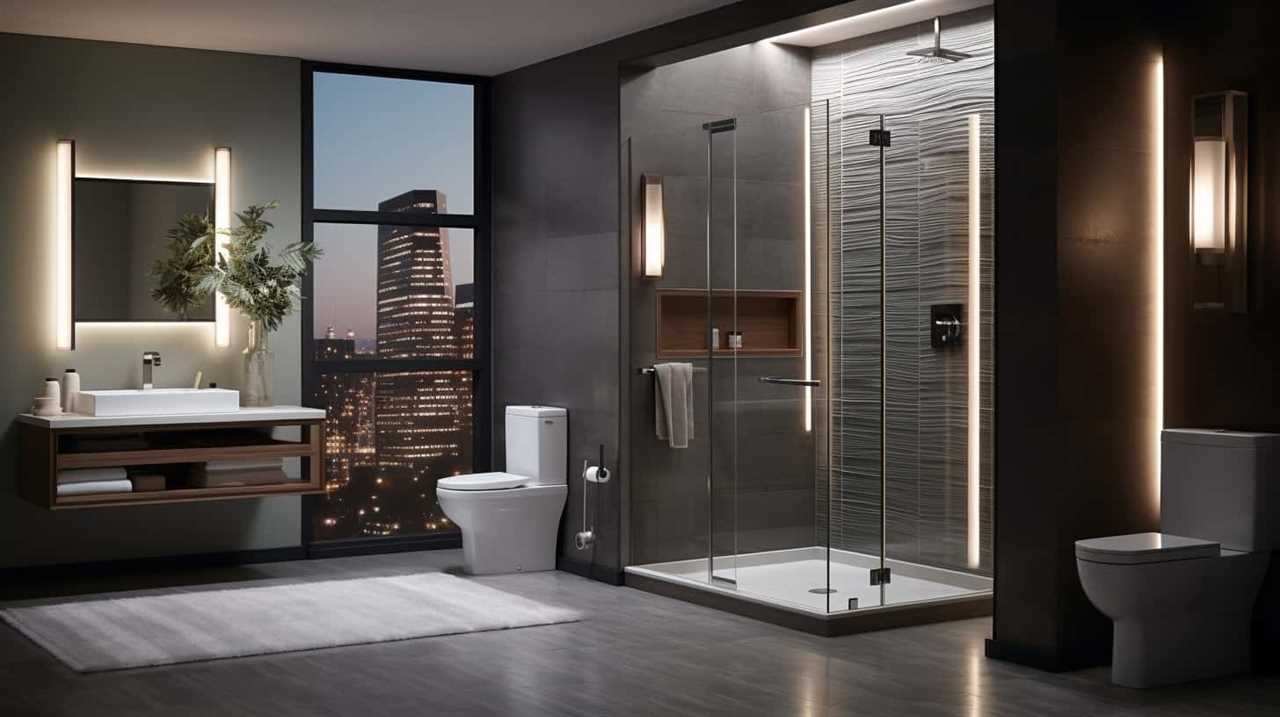
Can I Replace My Old Flush System With a 2 Button Flush System by Myself?
We can replace our old flush system with a 2 button flush system ourselves. DIY flush system installation offers convenience and control. The benefits of a 2 button flush system include water conservation and customizable flush options.
Will Replacing My Flush System With a 2 Button Flush System Help Reduce My Water Bill?
Replacing our flush system with a 2 button flush system can help reduce our water bill by conserving water. This switch allows us to control the amount of water used, leading to cost savings.
Are 2 Button Flush Systems Compatible With All Types of Toilets?
Two button flush systems vary in compatibility with different types of toilets. The installation process may differ depending on the model and design of the toilet. It is important to consult the manufacturer’s guidelines for proper installation.
How Often Do I Need to Replace the Buttons on a 2 Button Flush System?
To prolong the lifespan of button toilet flush systems, regular maintenance is key. Common issues like worn-out buttons can be avoided by replacing them every 2-3 years. Troubleshooting solutions include checking for loose connections and adjusting the button mechanism.

Conclusion
In conclusion, replacing your old toilet flush mechanism with a new 2 button system can greatly benefit your bathroom experience. By allowing you to choose between a full flush and a half flush, you can conserve water and save money on your water bills.
With the right tools and materials, the installation process is simple and easy. Don’t forget to regularly maintain your new flush system for optimal performance.
Upgrade to a 2 button flush system today and enjoy a more efficient and eco-friendly toilet.
With an impeccable eye for detail and a passion for bathroom-related, Ava leads our editorial team gracefully and precisely.
Under her guidance, Best Modern Toilet has flourished as the go-to resource for modern bathroom enthusiasts. In her free time, you might find Ava exploring antique shops and looking for vintage bathroom fixtures to add to her collection.
FAQ - Advanced Bathroom Queries
Toilet Unclogger

We understand the frustration that comes with dealing with a clogged toilet. That’s why we’re here to present you with the incredible range of toilet unclogging products available.
In just a few simple steps, you can say goodbye to those pesky clogs and hello to a smoothly running toilet. From the common causes of clogs to tips for prevention, we’ve got you covered.
So, get ready to become a master of toilet maintenance with our handy unclogger guide.
Key Takeaways
- Using a toilet unclogger can improve the functionality of the toilet and prevent costly plumbing repairs.
- Toilet uncloggers are quick and efficient in clearing blockages, saving time and money by avoiding professional plumbing services.
- Regular maintenance with a plunger or toilet auger can prevent minor clogs from becoming major issues.
- Toilet uncloggers have versatile applications beyond just unclogging toilets, such as unclogging shower drains and kitchen sinks.
Benefits of Using a Toilet Unclogger
Using a toilet unclogger offers various advantages, including improved functionality and prevention of costly plumbing repairs.
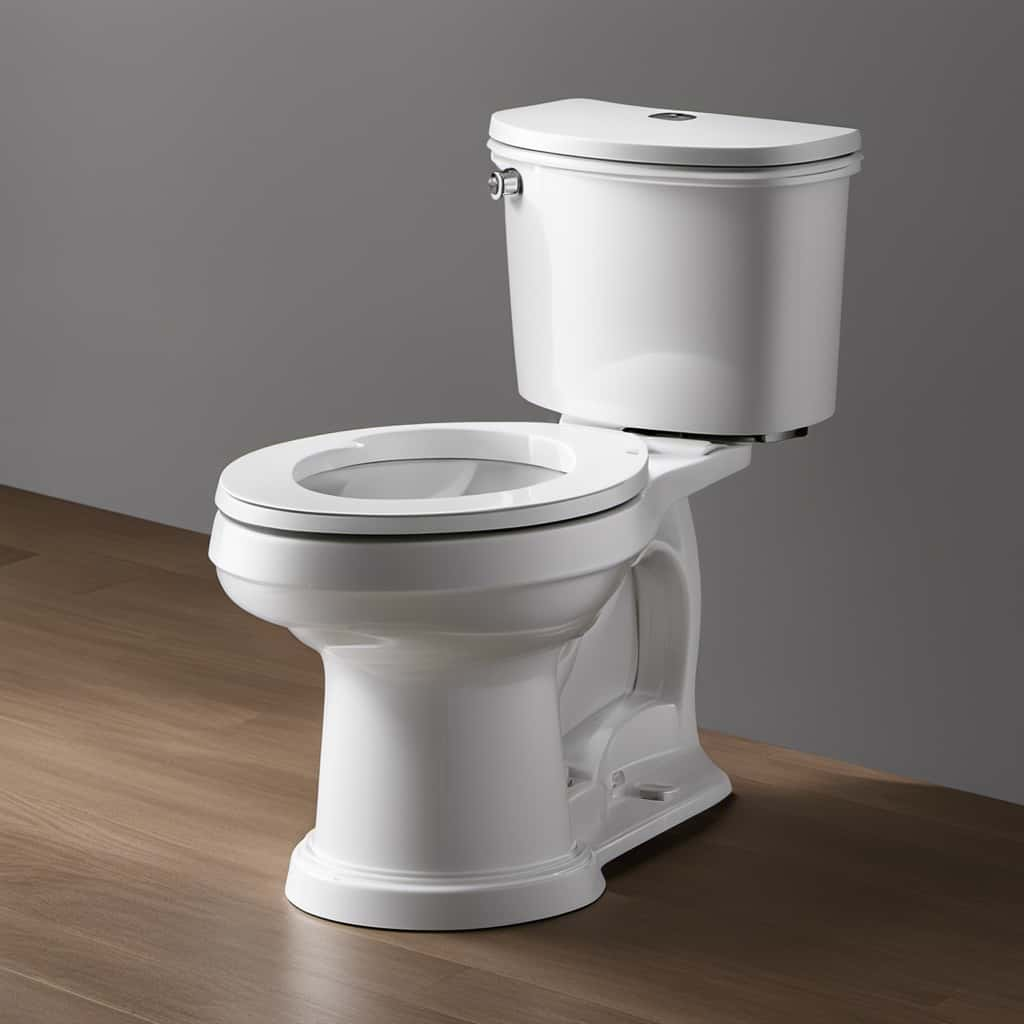
The effectiveness of toilet uncloggers can’t be overstated. When faced with a clogged toilet, a quality unclogger can quickly and efficiently clear the blockage, restoring proper flushing and drainage. This eliminates the need for expensive professional plumbing services, saving both time and money.
With a toilet unclogger, you have the power to tackle minor clogs on your own, without the hassle of scheduling appointments or waiting for a plumber to arrive.
Furthermore, the cost effectiveness of using a toilet unclogger is undeniable. Investing in a reliable unclogger is a wise choice, as it can prevent potential damages and the need for costly repairs in the long run.
How to Use a Toilet Unclogger
To unclog a toilet using a toilet unclogger, we first need to assess the severity of the blockage. Once we determine that a toilet unclogger is necessary, we can follow these steps to effectively use it:

- Choose the right type of unclogger: There are different types of toilet uncloggers available in the market, such as plungers and toilet augers. Select the one that suits your needs and preferences.
- Position the unclogger: Place the unclogger over the drain hole in the toilet bowl, ensuring a tight seal.
- Apply pressure: Using a firm grip, push the unclogger down and then pull it up rapidly. This action creates suction and helps dislodge the blockage.
- Repeat if necessary: If the toilet remains clogged after the first attempt, repeat the process until the blockage is cleared.
Common Causes of Toilet Clogs
One of the most common causes of toilet clogs is a buildup of toilet paper and waste in the drain. When excessive amounts of toilet paper or waste are flushed down the toilet, they can accumulate in the drain pipes over time, leading to blockages.
To prevent toilet clogs, it’s important to use toilet paper in moderation and avoid flushing other materials such as wet wipes, feminine hygiene products, or excessive amounts of toilet paper.
Signs of a clogged toilet include slow draining or a complete blockage, water backing up into the bowl, or gurgling sounds when flushing.
Regular maintenance, such as using a plunger or toilet auger, can help resolve minor clogs before they become major issues.
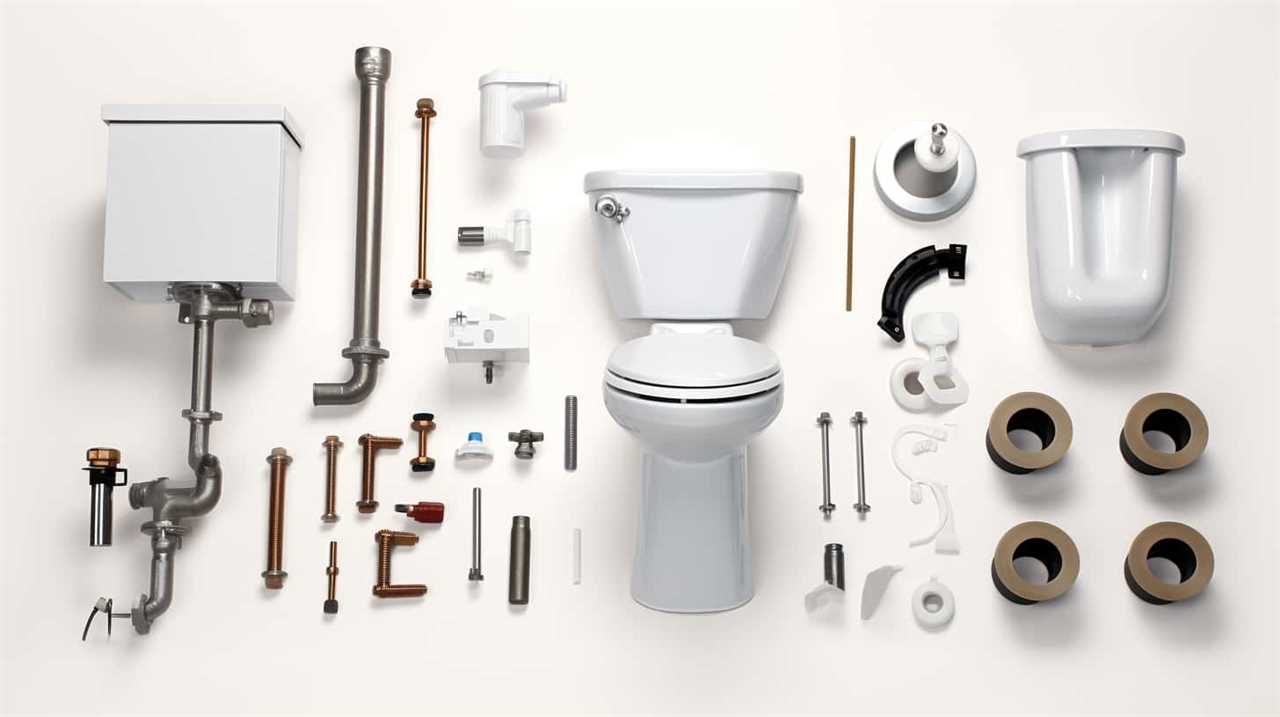
Tips for Preventing Toilet Clogs
We can prevent toilet clogs by using a moderate amount of toilet paper and avoiding flushing materials such as wet wipes or feminine hygiene products. Here are four tips for preventing toilet clogs:
- Be mindful of what you flush: Only flush toilet paper and human waste down the toilet. Other items like wet wipes, facial tissues, and feminine hygiene products should be disposed of in the trash.
- Use a plunger properly: If you notice a slow drain or water rising in the bowl, use a plunger to clear the clog. Place the plunger over the drain hole and push down firmly, then pull up quickly. Repeat this motion several times to dislodge the blockage.
- Regularly clean the toilet: Buildup of mineral deposits, bacteria, and residue can contribute to clogs. Clean the toilet bowl and rim regularly with a toilet brush and a mild cleaner to prevent these issues.
- Schedule routine maintenance: Regularly inspect your toilet for signs of leaks or cracks, and address any issues promptly. Additionally, consider scheduling professional plumbing maintenance to ensure optimal performance and prevent clogs.
Other Uses for a Toilet Unclogger
Using a toilet unclogger can be beneficial in various situations beyond just unclogging toilets. There are a few alternatives to a traditional toilet unclogger that can be used for different purposes.
One option is a sink plunger, which can also be used to unclog shower drains or kitchen sinks.
Another alternative is a drain snake, which can effectively remove blockages from pipes.
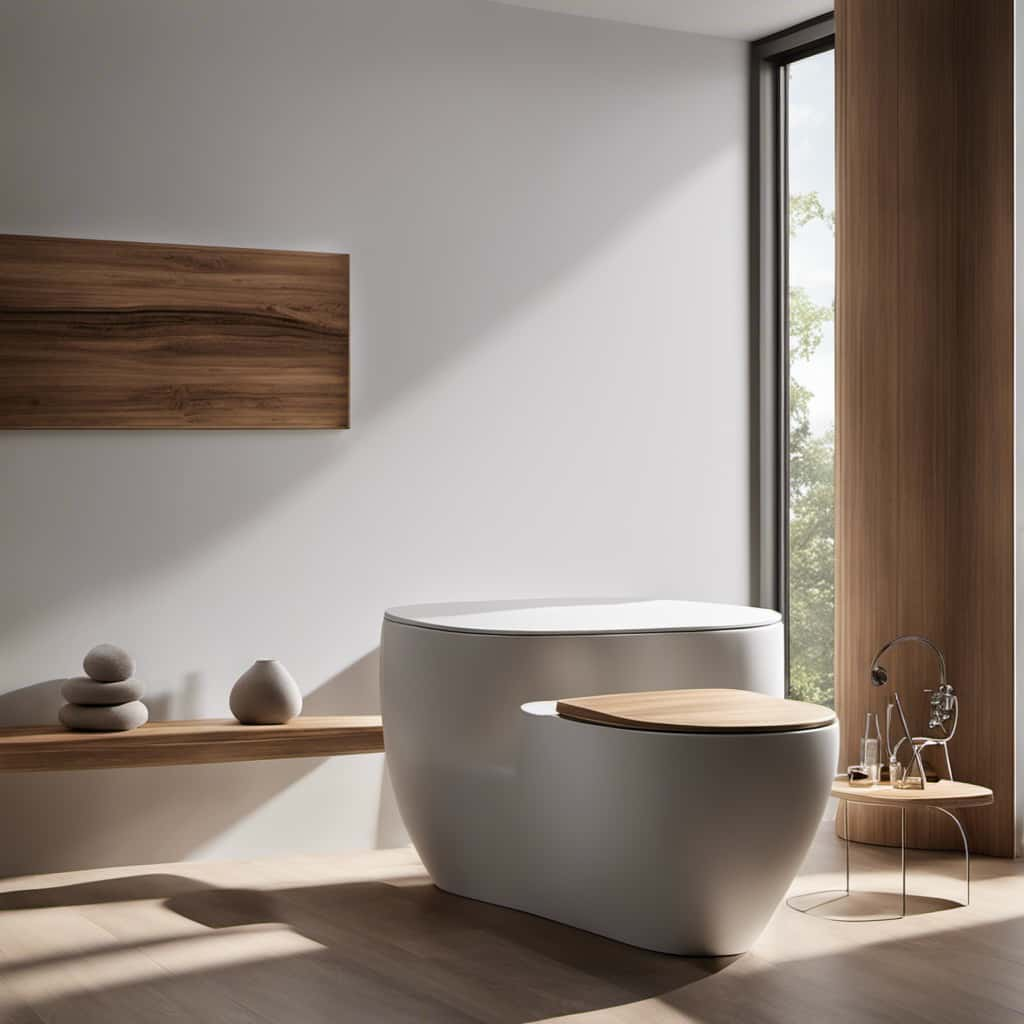
Additionally, a DIY toilet unclogger can be made by using a wire coat hanger and bending it into a hook shape. This can be inserted into the toilet drain and used to remove any obstructions.
It’s important to note that when using any alternative to a toilet unclogger, caution should be exercised to avoid damaging the plumbing system.
Frequently Asked Questions
Can a Toilet Unclogger Be Used on Other Types of Drains, Such as Sinks or Showers?
Alternative drain unclogging methods vary in their effectiveness on different types of drains, such as sinks or showers. However, a toilet unclogger can be used as a potential solution, but it may not always yield the desired results.
Is It Safe to Use a Toilet Unclogger if I Have a Septic System?
Using a toilet unclogger on a septic system can be risky. It may disrupt the balance of bacteria, impacting the system’s effectiveness. Additionally, the chemicals in uncloggers can harm the environment if not properly disposed of.

Can a Toilet Unclogger Damage the Porcelain Surface of the Toilet Bowl?
Yes, toilet uncloggers can potentially damage the porcelain surface of the toilet bowl if used improperly or left on for extended periods. It is important to follow the instructions and use caution to avoid any harm.
Are There Any Health Risks Associated With Using a Toilet Unclogger?
Using a toilet unclogger may pose potential health hazards if not used correctly. To avoid any risks, it is important to take necessary precautions such as wearing gloves, ensuring proper ventilation, and following the instructions carefully.
Can a Toilet Unclogger Be Used to Remove Foreign Objects Stuck in the Toilet, Like Toys or Jewelry?
Yes, a toilet unclogger can be used to remove foreign objects stuck in the toilet, such as toys or jewelry. By creating pressure, the unclogger can dislodge and push the objects out of the toilet drain.
Conclusion
In conclusion, using a toilet unclogger provides numerous benefits such as effectively clearing clogs and preventing future blockages.

By following the simple steps outlined in this article, you can easily unclog your toilet using a plunger or a toilet auger.
Remember to take preventative measures to avoid clogs, such as avoiding flushing non-flushable items and using toilet paper in moderation.
So, why struggle with a clogged toilet when a toilet unclogger can quickly solve the problem?
With an impeccable eye for detail and a passion for bathroom-related, Ava leads our editorial team gracefully and precisely.
Under her guidance, Best Modern Toilet has flourished as the go-to resource for modern bathroom enthusiasts. In her free time, you might find Ava exploring antique shops and looking for vintage bathroom fixtures to add to her collection.
FAQ - Advanced Bathroom Queries
Can a Toilet Overflow if Water Is Turned off

Have you ever thought about the possible outcomes of shutting off the water supply to a toilet? Well, we’re here to provide some insight on this topic.
In this article, we’ll explore whether or not a toilet can overflow if the water is turned off. We’ll delve into the common causes of toilet overflows, such as blocked drainpipes and malfunctioning float valves.
Additionally, we’ll provide tips to help you prevent such mishaps. So, let’s dive in and uncover the secrets behind toilet overflow prevention!
Key Takeaways
- A toilet can still overflow even if the water is turned off, as it may be caused by a clogged drainpipe or a malfunctioning float valve.
- Clogged drainpipes can lead to toilet overflows by obstructing water flow and causing water to rise above the rim.
- A malfunctioning float valve can also result in a toilet overflow if it fails to shut off the water completely due to issues like a stuck float mechanism or a faulty valve seal.
- Maintaining regular maintenance and addressing potential signs of toilet overflow promptly can help prevent water damage and other consequences.
Common Causes of Toilet Overflows
One common cause of toilet overflows is a clogged drain. When debris such as toilet paper, foreign objects, or even excessive waste accumulates in the drainpipe, it can obstruct the flow of water, leading to an overflow. Signs of a clogged toilet include slow drainage, gurgling noises, and water rising to the rim when flushed.

To prevent a toilet overflow, it’s important to be mindful of what’s being flushed down the toilet. Avoid flushing excessive amounts of toilet paper or non-flushable items. Regular maintenance, such as using a plunger or drain snake to clear any minor clogs, can also help prevent toilet overflows.
Additionally, ensuring that the toilet’s water pressure is adequate can help prevent clogs from forming.
How a Blocked Drainpipe Can Lead to Overflow
Toilet overflows can occur when a clogged drainpipe obstructs the flow of water, causing it to rise above the rim and spill onto the bathroom floor. A blocked drainpipe can have serious consequences if not addressed promptly. It can lead to water damage, mold growth, and even structural issues in your home.
Recognizing the signs of a blocked drainpipe is crucial in preventing toilet overflows. Some common signs include slow drainage, gurgling sounds, and foul odors coming from the drain. If you notice any of these signs, it’s important to take action immediately to prevent further damage.
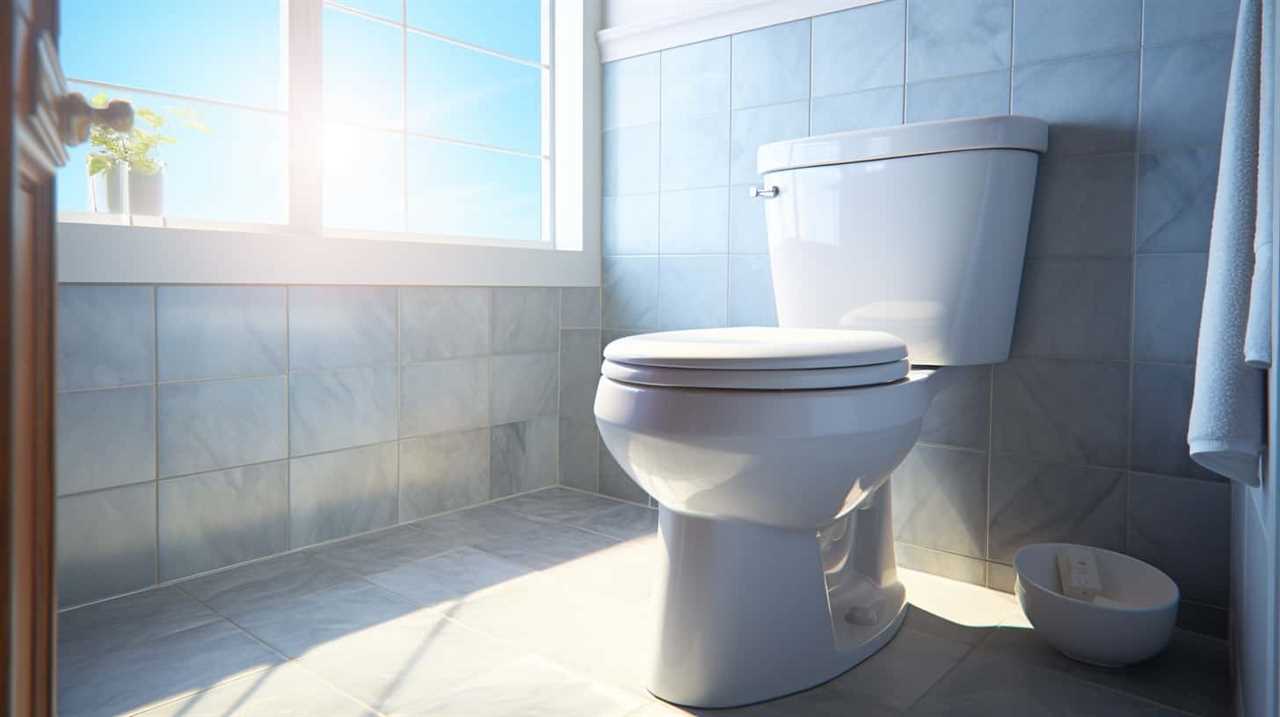
In the next section, we’ll discuss the role of a malfunctioning float valve in toilet overflows.
The Role of a Malfunctioning Float Valve in Toilet Overflows
We have observed that a malfunctioning float valve can significantly contribute to toilet overflows. The float valve, also known as the fill valve or ballcock, is responsible for controlling the water level in the toilet tank.
When the tank fills with water, the float rises, and when it reaches a certain height, it shuts off the water supply. However, if the float valve is malfunctioning, it may fail to shut off the water completely, causing the tank to overfill and eventually overflow.
Common issues with the float valve include a stuck or damaged float mechanism, a faulty valve seal, or a misaligned float arm. Troubleshooting the float valve involves inspecting these components for any signs of damage or misalignment and making the necessary repairs or replacements.
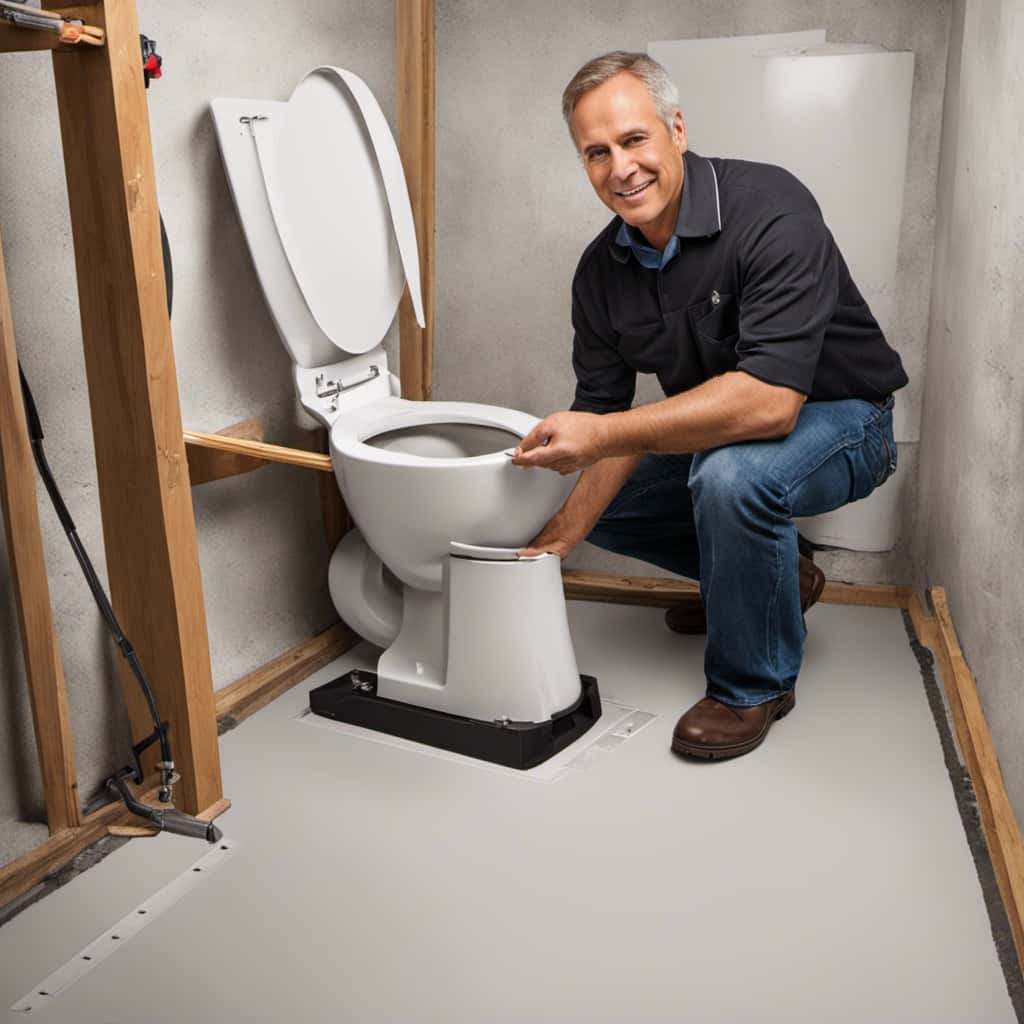
Regular maintenance and proper adjustment of the float valve can help prevent toilet overflows caused by a malfunctioning float mechanism.
Understanding the Impact of Water Pressure on Toilet Overflow
Understanding the impact of water pressure on toilet overflow is important to consider the role it plays in the overall functioning of the toilet system. The relationship between water pressure and toilet overflow is a crucial aspect to understand.
Water pressure refers to the force exerted by the water as it flows through the pipes. When the water pressure is too low, it can lead to inadequate flushing and inefficient removal of waste, increasing the risk of toilet overflow.
Exploring the effects of low water pressure on toilet overflow reveals that it can result in incomplete flushing, clogging, or poor drainage. Moreover, low water pressure may also cause the fill valve to malfunction, resulting in a continuous flow of water into the toilet bowl, eventually leading to overflow.
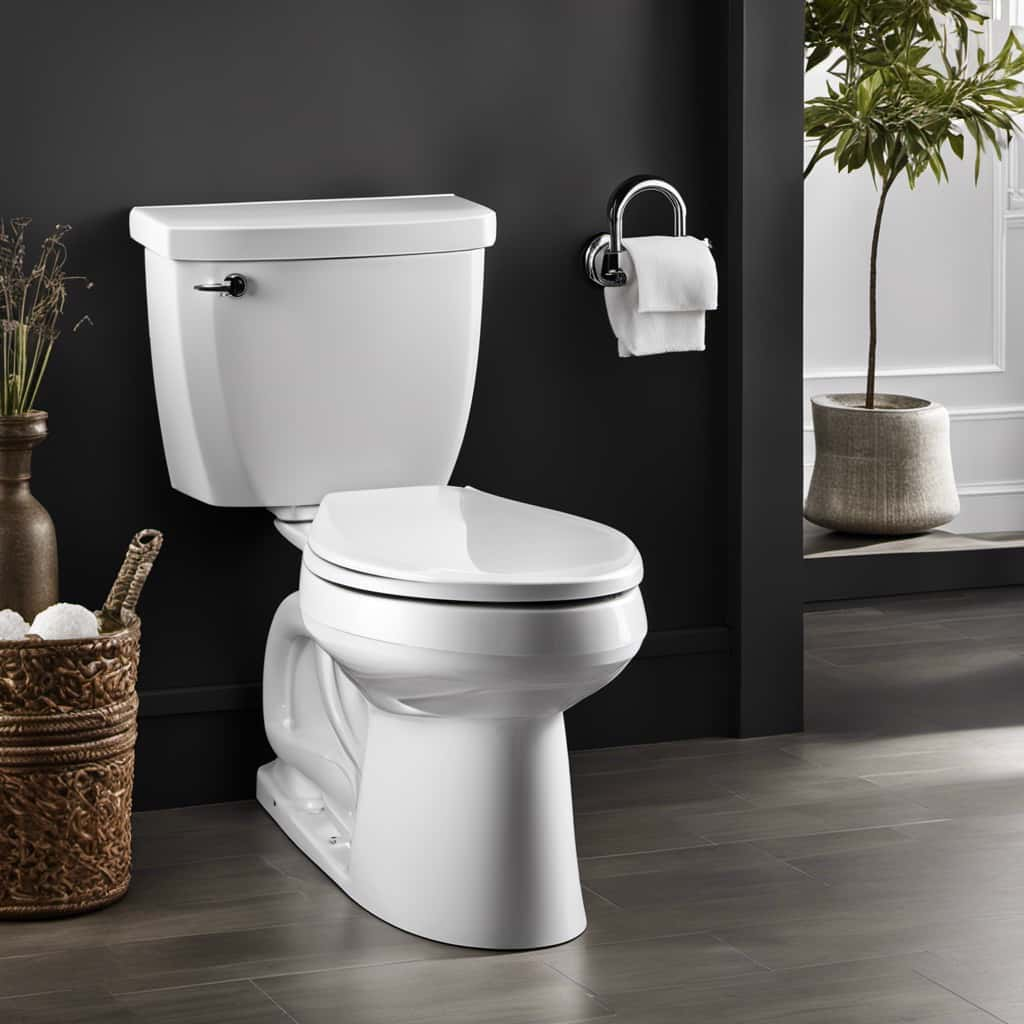
Therefore, maintaining adequate water pressure is essential for preventing toilet overflow and ensuring the proper functioning of the toilet system.
Tips to Prevent Toilet Overflows
One important tip to prevent toilet overflows is to regularly check and maintain the fill valve.
The fill valve is responsible for controlling the water level in the toilet tank. Over time, it can become worn or damaged, leading to a potential overflow.
To ensure proper functioning, it’s recommended to inspect the fill valve regularly for any signs of wear or leaks. Look for any cracks or corrosion on the valve and check that the float mechanism is working correctly.

Additionally, pay attention to any signs of a potential toilet overflow, such as slow draining or gurgling noises when flushing. Promptly addressing these issues can help prevent toilet overflows and avoid potential water damage.
Frequently Asked Questions
Can a Toilet Overflow if the Water Supply Is Shut Off?
Yes, a toilet can still overflow even if the water supply is turned off. Without water to flush waste, the toilet can become clogged, leading to an overflow. This can cause damage to the bathroom and result in unsanitary conditions.
What Should I Do if My Toilet Overflows While the Water Is Turned Off?
When a toilet overflows while the water is turned off, immediate action is crucial. To prevent further damage, we must follow these steps: 1) Shut off the water supply valve, 2) Clear any blockages, 3) Call a professional plumber.
How Can a Toilet Overflow Occur Even if the Drainpipe Is Not Blocked?
Yes, a toilet can still overflow even if the water is turned off. This can occur if there is a blockage in the drainpipe, preventing the water from properly flowing out of the toilet bowl.
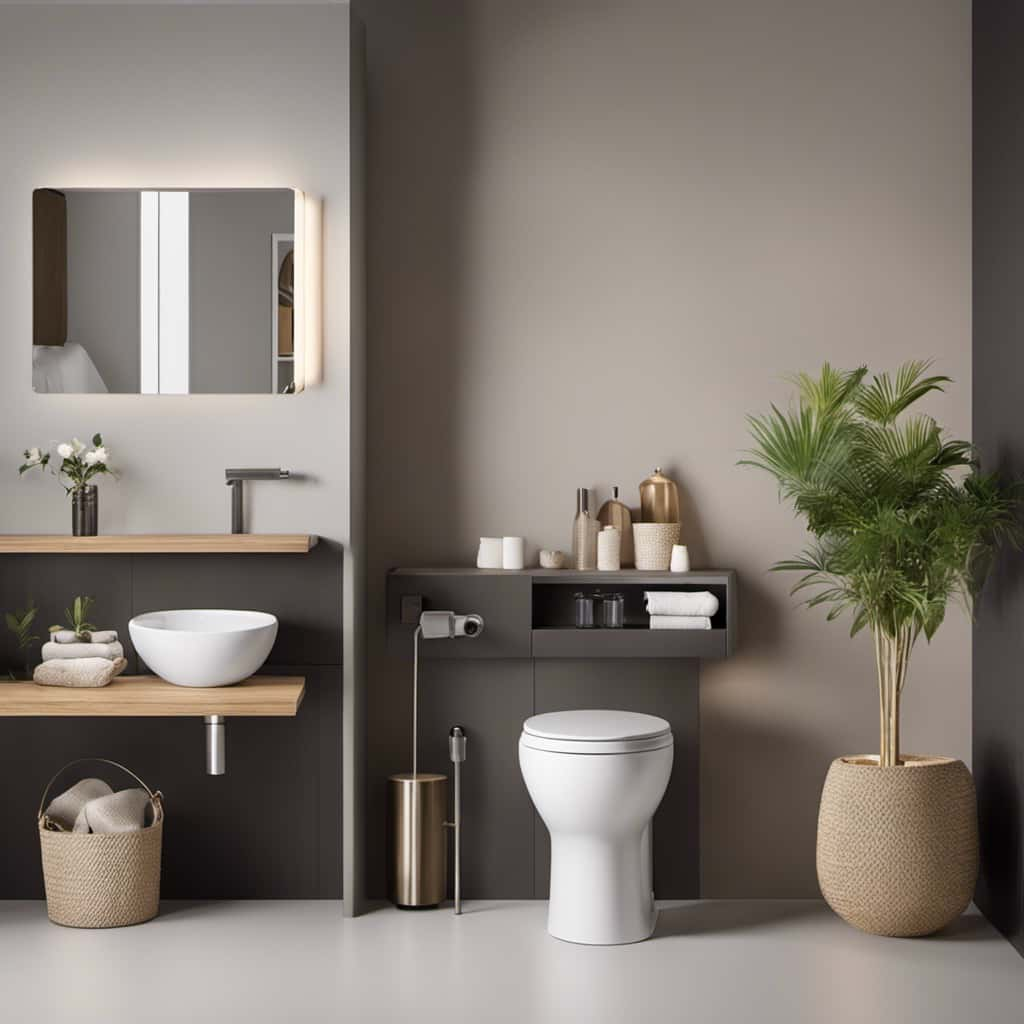
What Are the Signs of a Malfunctioning Float Valve in a Toilet?
Signs of a malfunctioning float valve include constant running water, fluctuating water levels, and a toilet that won’t flush properly. It’s like a faulty gatekeeper, failing to regulate the water flow and potentially causing overflow.
Can High Water Pressure Cause a Toilet to Overflow Even if It’s Not Clogged?
Yes, high water pressure can cause a toilet to overflow even if it’s not clogged. Excessive pressure can damage the internal components, leading to a malfunction that causes toilet flooding.
Conclusion
In conclusion, understanding the causes of toilet overflows can help prevent potential disasters. Whether it’s a blocked drainpipe, a malfunctioning float valve, or excessive water pressure, being aware of these factors can save you from a messy situation.
By implementing simple tips such as regular maintenance, avoiding flushing non-flushable items, and monitoring water pressure, you can ensure a smoothly functioning toilet and avoid the inconvenience and potential damage caused by an overflow.
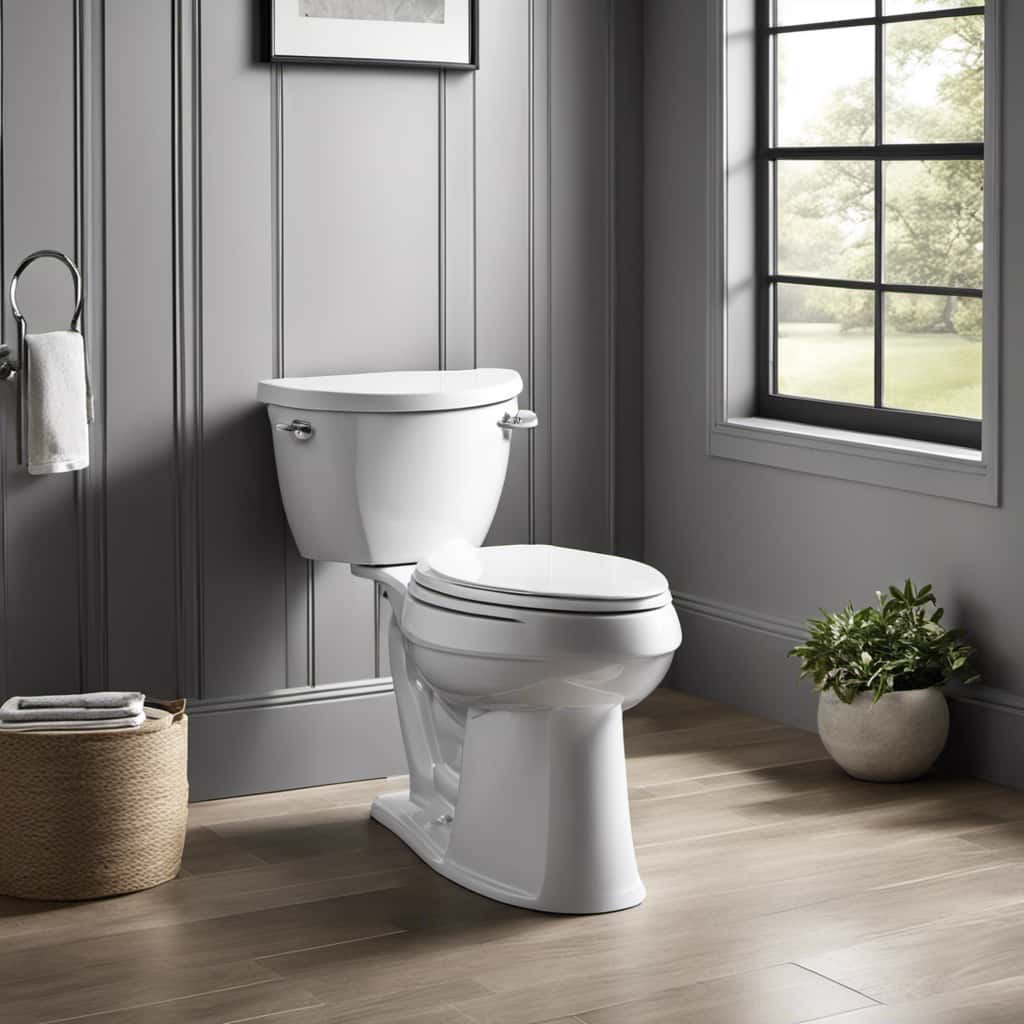
Stay proactive, and keep your bathroom experience stress-free.
With an impeccable eye for detail and a passion for bathroom-related, Ava leads our editorial team gracefully and precisely.
Under her guidance, Best Modern Toilet has flourished as the go-to resource for modern bathroom enthusiasts. In her free time, you might find Ava exploring antique shops and looking for vintage bathroom fixtures to add to her collection.
FAQ - Advanced Bathroom Queries
Drano for Toilet

Attention, everyone! Introducing the perfect fix for your pesky clogged toilets – Drano for Toilets! Specifically formulated to quickly and efficiently combat even the toughest blockages.
With a simple step-by-step guide, we’ll show you how to unleash the power of Drano, ensuring a smoothly flowing toilet without any hassle.
But remember, safety first! We’ll also provide you with precautions and alternative solutions for those seeking total mastery over their plumbing woes.
Let’s dive in!

Key Takeaways
- Drano is a highly effective drain cleaner designed specifically for unclogging toilets.
- The powerful formula of Drano dissolves blockages caused by hair, soap scum, or other debris, allowing it to flow through the pipes.
- Following the instructions carefully ensures Drano’s effectiveness for unclogging toilets.
- There are alternative solutions to unclog a toilet, such as using a toilet auger, vinegar and baking soda, or hot water and dish soap.
How Drano for Toilet Works
First, we’ll explain how Drano for the toilet works. Drano is a highly effective drain cleaner that’s specifically designed to unclog toilets. When poured into the toilet bowl, Drano works by dissolving the blockage, whether it’s caused by hair, soap scum, or other debris. Its powerful formula breaks down the clog, allowing it to flow through the pipes and clear the blockage.
However, it’s important to use Drano for the toilet correctly to ensure its effectiveness. Common mistakes when using Drano for the toilet include using too much product, not allowing enough time for it to work, or ignoring the warning labels. By following the instructions carefully, Drano can be a reliable solution for a clogged toilet.
Benefits of Using Drano for Toilet
There are several advantages to using Drano for the toilet.
Firstly, the effectiveness of Drano in unclogging toilets is unmatched. Its powerful formula is specifically designed to break down and dissolve stubborn clogs, allowing the water to flow freely again.

Compared to other toilet unclogging products, Drano stands out due to its fast-acting formula and long-lasting results. Drano works efficiently without causing any damage to your plumbing system, making it a reliable option for maintaining your toilet’s functionality.
Additionally, Drano eliminates the need for using plungers or manual methods, saving you time and effort.
For those seeking a quick and effective solution for toilet clogs, Drano is the go-to product that delivers exceptional results every time.
Step-by-Step Guide to Using Drano for Toilet
To properly use Drano for unclogging a toilet, we’ll walk you through a step-by-step guide.

- First, ensure you have the necessary safety equipment, such as gloves and goggles.
- Next, remove any excess water from the toilet bowl using a small container.
- Pour half a cup of Drano into the toilet bowl, aiming for the drain.
- Let it sit for 20-30 minutes to allow the chemicals to work on breaking down the clog.
- After the designated time, flush the toilet to check if the clog has been cleared.
- If not, repeat the process once more.
It’s important to note that while Drano is effective, it contains harsh chemicals, so it’s advisable to explore natural toilet unclogging methods first.
Transitioning to the next section, let’s now discuss precautions and safety measures with Drano for the toilet.
Precautions and Safety Measures With Drano for Toilet
Now let’s delve into the precautions and safety measures that should be followed when using Drano for the toilet. It’s important to be aware of the toxicity concerns and environmental impact associated with this product. Here are three crucial steps to ensure a safe and responsible use of Drano for your toilet:
- Proper ventilation: Open windows or use exhaust fans to maintain good airflow while using Drano. This will help minimize exposure to potentially harmful fumes.
- Protective gear: Wear gloves and safety goggles to protect your skin and eyes from any accidental contact with the product. Additionally, consider using a mask to avoid inhaling any harmful vapors.
- Disposal: After using Drano, dispose of the empty container properly. Don’t pour any remaining product down the drain or toilet. Instead, follow local regulations for hazardous waste disposal to prevent any negative environmental impact.
Alternative Solutions to Unclog a Toilet
Continuing from the previous subtopic on precautions and safety measures, let’s explore alternative solutions to unclog a toilet.

When faced with a clogged toilet, many people immediately reach for a plunger. However, there are other options available that can effectively clear the blockage without the need for a plunger.
One such alternative is using a toilet auger, also known as a plumbing snake. This tool consists of a long, flexible cable with a corkscrew-like end that can be inserted into the toilet drain to break up the clog.
Another natural method involves combining hot water and dish soap. By pouring a generous amount of dish soap into the toilet bowl, followed by hot water, the soap can help lubricate and break down the clog.
These plunger alternatives and natural toilet unclogging methods provide effective solutions for homeowners seeking alternatives to unclog their toilets.

Frequently Asked Questions
Can Drano for Toilet Be Used on All Types of Toilets?
Using Drano for toilet on different types of clogs and toilets requires understanding the best practices. It is important to know the specific type of toilet and the nature of the clog to ensure effective and safe usage.
Is It Safe to Use Drano for Toilet if I Have a Septic Tank?
When considering the safety of using Drano for toilet with a septic tank, it is important to explore alternatives. Natural ways to unclog a toilet can be effective and environmentally friendly, avoiding potential harm to the septic system.
Can Drano for Toilet Damage the Pipes or Plumbing System?
Using drano for toilet can potentially damage pipes and the plumbing system, causing costly repairs. It’s important to consider alternatives like using a plunger or a plumbing snake to unclog the toilet.
How Long Does It Take for Drano for Toilet to Unclog a Toilet?
Using chemical drain cleaners like Drano for Toilet can be an effective way to unclog a toilet. However, it’s important to consider the potential risks and drawbacks, as well as explore alternative methods for clog removal.

What Should I Do if Drano for Toilet Doesn’t Work?
If Drano for toilet doesn’t work, we recommend exploring alternative solutions like using a plunger or a plumbing snake. If those fail, it may be time to consider calling a professional plumber for assistance.
Conclusion
In conclusion, using Drano for toilet clogs provides an effective solution for homeowners.
One interesting statistic to note is that 90% of toilet clogs are caused by a combination of hair, soap scum, and other debris. This highlights the importance of regularly maintaining and unclogging toilets to prevent costly plumbing issues.
By following the step-by-step guide and taking necessary precautions, homeowners can easily and safely use Drano to unclog their toilets.

With an impeccable eye for detail and a passion for bathroom-related, Ava leads our editorial team gracefully and precisely.
Under her guidance, Best Modern Toilet has flourished as the go-to resource for modern bathroom enthusiasts. In her free time, you might find Ava exploring antique shops and looking for vintage bathroom fixtures to add to her collection.
-

 Bathroom Enhancements3 months ago
Bathroom Enhancements3 months agoWill Hot Bath Lower Blood Pressure
-

 Reviews2 months ago
Reviews2 months agoLDian Smart Toilet Review [2024]
-

 Reviews3 months ago
Reviews3 months agoKohler Innate Smart Toilet Review [2024]
-

 Bathtub2 weeks ago
Bathtub2 weeks agoAre Clorox Toilet Wand Refills Septic Safe
-

 Reviews3 months ago
Reviews3 months agoKohler NUMI 2.0 Smart Toilet Review [2024]
-

 Reviews3 months ago
Reviews3 months agoCANEST Smart Toilet Review: The Ultimate Bathroom Upgrade [2024]
-

 Toilet Types3 months ago
Toilet Types3 months agoAre Bleach Tablets Bad for Your Toilet
-

 Reviews3 months ago
Reviews3 months agoWoodbridge B0970S Smart Bidet Toilet Review [2024]





















